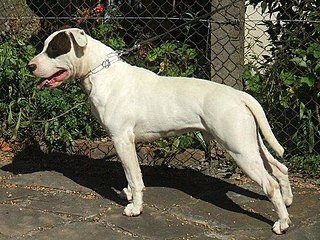
The Great Dane, also known as the German Mastiff or Deutsche Dogge, is a breed of dog from Germany. The Great Dane descends from hunting dogs known from the Middle Ages and is one of the largest breeds in the world.

The Presa Canario is a Spanish breed of large dog of mastiff or catch dog type. It originates in the autonomous region of the Canary Islands, and is found mostly in the islands of Gran Canaria and Tenerife. It was formerly known as the Dogo Canario. It was traditionally used as a guard dog, as a herding dog for both sheep and cattle, and for dog-fighting, which was legal in Spain until 1936 and may have continued clandestinely thereafter.

The Fila Brasileiro, or Brazilian Mastiff, is a large working breed of dog developed in Brazil. It is known for its superb tracking ability, aggressiveness and an unforgiving, impetuous temperament. Rather than attacking its prey, the Fila traps it and waits for the hunter to arrive. Owing to these qualities, the Fila Brasileiro is used as a guard dog, as a cattle dog for livestock and as a hunting dog for tracking and controlling large game. When slavery was legal in Brazil in the 18th century, the Fila Brasileiro was used to return fugitive slaves unharmed to their masters.

A guard dog or watchdog is a dog used to guard property against, and watch for, unwanted or unexpected human or animal intruders.

The Alaunt is an extinct breed of dog, with the original breed having existed in North Caucasus, Central Asia and Europe from ancient times until the 17th century.

The Argentine Dogo is a large, white, muscular breed of dog that was developed in Argentina primarily for the purpose of big-game hunting, including wild boar. The breeder, Antonio Nores Martínez, also wanted a dog that would exhibit steadfast bravery and willingly protect its human companion. It was first bred in 1928 from the Cordoba Fighting Dog, along with a wide array of other breeds, mainly bulldogs and terriers, including the Great Dane, Dogue de Bordeaux, Pointer, Bull and terrier etc.

The Dogue de Bordeaux, Bordeaux Mastiff, French Mastiff or Bordeauxdog is a large French mastiff breed. A typical brachycephalic mastiff breed, the Bordeaux is a very powerful dog, with a very muscular body. This muscular breed has been put to work pulling carts, transporting heavy objects, and guarding flocks.

The Cordoba Fighting Dog is an extinct breed of fighting dog. The Cordoba was a crossbreed of the Boxer, Bulldog, Bull Terrier, and the English Mastiff. The Dogo Argentino is directly derived from this breed.

Bulldogs are a type of dog that were traditionally used for the blood sports of baiting and dog fighting, but today are kept for other purposes, including companion dogs, guard dogs and catch dogs. Bulldogs are typically stocky, powerful, square-built animals with large, strong, brachycephalic-type muzzles. It is believed bulldogs were developed during the 16th century in the Elizabethan era from the larger mastiffs, as smaller, more compact dogs were better suited for baiting.
La Real Sociedad Canina de España was founded as the Real Sociedad Central de Fomento de las Razas Caninas en España (R.S.C.F.R.C.E.) on 27 June 1911, and incorporated in Madrid, Spain on 12 July 1911.

The Ca de Bou, also known as the Perro de Presa Mallorquin or the Majorcan Bulldog, is a breed of bulldog type dogs from Majorca, the largest of the Balearic Islands.

Dogo cubano, Cuban dogge, Cuban bloodhound and Cuban mastiff are names for an extinct landrace or breed of domestic dog from Cuba. It was of the dogo sub-type of the bullmastiff dog type, which as a general class was used for bull-baiting and dog fighting.

The Saint Miguel Cattle Dog is a dog breed of mastiff type originating on São Miguel Island in the Azores, an island chain which is one of the autonomous regions of Portugal. The breed was originally used as a herding dog for working with cattle.

The Villano de Las Encartaciones is a Spanish working dog from the region of Las Encartaciones in the province of Biscay, in the Basque country, and to some extent in Álava, in eastern Cantabria and in northern Burgos. The traditional use of the dogs is in management of the Monchina breed of cattle of Cantabria and the Paìs Vasco, and particularly to assist with bringing the cattle down from the mountain pastures between October and December. The association between the dog breed and the cattle breed is so close that it has been said that "one breed could not exist without the other". In 2009 there were fewer than 200 dogs registered in the studbook.

The Andalusian Hound is a warren hound dog breed originating in Spain, especially Andalusia. These dogs are similar to other Iberian warren hounds such as the Ibizan Hound, the Portuguese Podengo, the Podenco Canario and the Maneto.

Brazilian Dogo, also called Brazilian Dogge, is a mastiff-type working dog breed originating in Brazil. It is neither recognized by the Fédération Cynologique Internationale (FCI) nor the American Kennel Club (AKC). However, it has the official Brazilian recognition by the Brazilian Confederation of Cynophilia (CBKC) where it belongs to the Group 11 - Breeds not recognized by the FCI.

The Terceira Mastiff is an extinct Portuguese dog landrace, also known as the Rabo Torto.

















